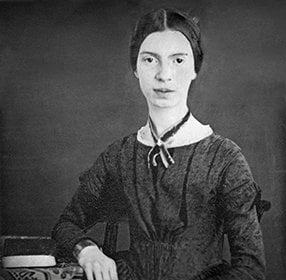 When I first read Because I could not stop for Death, I was utterly confused by the language and plot of the poem. Similar to many of Dickinson’s other works, this poem is full of dashes and interjections, in addition to the capitalization of seemingly random words throughout. This made the first few reads of the poem very difficult, but as I read on, I started to find plausible explanations for Dickinson’s poetical choices.
When I first read Because I could not stop for Death, I was utterly confused by the language and plot of the poem. Similar to many of Dickinson’s other works, this poem is full of dashes and interjections, in addition to the capitalization of seemingly random words throughout. This made the first few reads of the poem very difficult, but as I read on, I started to find plausible explanations for Dickinson’s poetical choices.
I tend to start my reading process by looking at the general structure. We can see that there are 6 stanzas in the poem, and only 2 sentences — the first stanza ends in a period, and then there are only dashes until the end. Each stanza contains four lines, and in every stanza except the third, the second and fourth lines rhyme. The basic structure of the poem is pretty much classic Emily Dickinson, similar to the other poems of hers that we have read.
 In the first stanza, we are introduced to two characters — the speaker and “Death”, who is capitalized and personified. Here commences the main plot of the poem, as the two of them (and “Immortality”) go on a carriage ride together. Immortality? That didn’t make any sense to me at first. First of all, Dickinson capitalizes the word, as if “Immortality” is a living being just like Death. Secondly, immortality is usually used to describe someone who lives forever, yet the speaker is using it in the context of a carriage ride with Death. It seemed to establish a juxtaposition between the concepts of life and death that I didn’t entirely know how to approach. If someone were to live forever, then how can they possibly die? Thinking that this might be resolved later on, I put this line aside and continued on.
In the first stanza, we are introduced to two characters — the speaker and “Death”, who is capitalized and personified. Here commences the main plot of the poem, as the two of them (and “Immortality”) go on a carriage ride together. Immortality? That didn’t make any sense to me at first. First of all, Dickinson capitalizes the word, as if “Immortality” is a living being just like Death. Secondly, immortality is usually used to describe someone who lives forever, yet the speaker is using it in the context of a carriage ride with Death. It seemed to establish a juxtaposition between the concepts of life and death that I didn’t entirely know how to approach. If someone were to live forever, then how can they possibly die? Thinking that this might be resolved later on, I put this line aside and continued on.
In the second stanza, Emily Dickinson starts her use of lethargic diction to portray the slow pace of the carriage ride. The two of them (the speaker and Death) “slowly drove” in the carriage, as “[Death] knew no haste”. This gives the impression that Death is the one driving the carriage and determining the pace of the journey, and the speaker must “put away [their] labor and leisure”. In these stanzas, the speaker describes Death as kind and civil, which is quite the contrast from what I usually think of when I envision death. And with the formalish setting of a carriage ride, perhaps Dickinson is suggesting that the process of going away with Death (i.e. dying) isn’t always a gruesome, horrible thing.

The third stanza was relatively easy to understand, compared to the others so far — or so I thought. As the speaker and Death proceed on their carriage ride, they pass various landmarks: a school, with children playing at recess “in the Ring”, then “Fields of Gazing Grain”, and finally the “Setting Sun”. The capitalized words definitely seem to have extra significance here. I thought that each of these landmarks was like a stop in the various stages of one’s life.

The school represents youth, the “Fields of Gazing Grain” represent adulthood, when the crops of one’s life are ripe for harvest, and finally the “Setting Sun”, which marks the finale of one’s time on earth. The alliteration that Dickinson employs here could be for the further emphasis of each stage of life.

However, even in this stanza, not everything is clear. There is the repetition of “We passed” at the start of every line, except for the second, where the speaker describes children at recess. Why did Dickinson choose to break the structure of the stanza? Honestly, I’m still not entirely sure.
But then, in the next paragraph, Dickinson states, “Or rather — He passed Us –”, which immediately made me doubt my interpretation. Who is “He”? Who is “Us”? Previously, the capitalized pronoun “He” was used to refer to the caricature of Death, yet I thought that the “Us” should also be referring to the speaker and Death. This made no sense to me, even after reading it multiple times. Only after reading it in direct connection with the previous line did I surmise that the “He” might not be referring to Death, but rather to the “Setting Sun”. But if that was true, this only brought up more questions. How did the sun pass the carriage? I guess it would be possible if the carriage was traveling at a very slow pace, as the sun set below the horizon and night set in.
The difficulty in the fourth stanza also arose because of the word choice. Dickinson opts for a lot of alliteration here, with “Gossamer” and “Gown”, and “Tippet” and “Tulle”. I didn’t know what most of those words meant, which made it extremely difficult to piece the poem together. Apparently, gossamer is a very thin fabric, similar to a spider’s web. A tippet is a type of scarf, while tulle is another type of soft, fine silk (thanks to Merriam-Webster for the definitions). Given the speaker’s thin clothing and the chill that they feel, it is as if the cold of Death is finally setting in after the initial civility that he showed — definitely a shift in the tone from pleasant to ominous.
One of the things that I was confused about was the significance of the house in the fifth stanza. Once again, there were unfamiliar words here, most notably “Cornice”. After consulting Merriam-Webster once again, I figured out that “Cornice” was referring to an ornamental decoration on the ceiling of a house. As the two characters pause before it, the speaker notes that the house is “in the Ground” and “the Roof was scarcely visible”. This made me think of the house as a final resting place underground, such as a tomb or, more metaphorically, the underworld. The speaker and death had finally reached their destination after what seemed like centuries. But I think what’s most interesting is that the speaker says “the Horses’ Heads / Were [heading] toward Eternity”, implying that this final resting place is also one of unlimited time. The relationship between Death, Immortality, and Eternity is a continuous concept throughout the poem that might be the most difficult thing to interpret. Perhaps Dickinson is suggesting that death is no different from eternal life, and that the true significance of life comes from the limited amount of time available to us.

Hi Dingjia! I have to give you credit for choosing another Emily Dickinson poem! I looked at multiple of her poems when I was trying to choose my poem, and I passed on them because I remembered how hard the ones that we read in class were. I think that you picked a super interesting one here, and it was one that I did not come across when I was looking for my poem. When I first read this poem, the main issue I had with it was the syntax. The use of so many dashes utterly confused me. I had never seen a poem that had so many dashes. It was like Dickinson decided to use the dashes to replace periods. Along with that, like you say in your essay, there are a lot of random words that are capitalized. These are all really interesting choices that Dickinson made when writing the poem, and I think it adds a level of depth to the poem. I think that you did a really good job of analyzing the poem for its structure and syntax, and your analysis really helped me better understand the plot of the poem, which I was also confused about. You did a really good job of explaining your thought process and why you think what you think. Good job!
Dingjia–thanks for taking us through your thought process. I appreciate how specific you explore the images Dickinson used. Like Luke, I have respect for you for selecting another Dickinson poem! I do love the Apple series based on her life–I think all of you would appreciate it now that you know about her 🙂